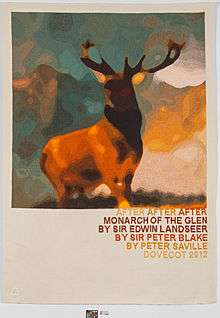The Monarch of the Glen (painting)
 | |
| Artist | Sir Edwin Landseer |
|---|---|
| Year | 1851 |
| Type | Oil-on-canvas |
| Location | National Museum of Scotland, Edinburgh (as loan from Diageo) |
The Monarch of the Glen is an oil-on-canvas painting of a red deer stag completed in 1851 by the English painter Sir Edwin Landseer, which was commissioned as part of a series of three panels to hang in the Palace of Westminster in London. It was one of the most popular paintings throughout the 19th century, and reproductions in steel engraving sold very widely, and the painting itself was finally bought by companies to use in advertising. The painting had become something of a cliché by the mid-20th century, as "the ultimate biscuit tin image of Scotland: a bulky stag set against the violet hills and watery skies of an isolated wilderness", according to the Sunday Herald.[1]
The painting is reportedly set in Glen Affric.[2]
The stag has twelve points on his antlers, which in deer terminology makes him a "royal stag" but not a "monarch stag", for which sixteen points are needed.[3]
History
Landseer was a member of the Royal Academy, a favourite of Queen Victoria, and had become famous for his paintings and drawings of animals. His later works include the sculptures of the lions at the foot of Nelson's Column in Trafalgar Square. From the 1840s, he produced a series of intricately observed studies of stags based on those he had seen on the trips he had been making to the Scottish Highlands since 1824. In 1850 Landseer received a national commission to paint three subjects connected with the chase for the Refreshment Rooms of the House of Lords, for which he produced Monarch of the Glen and two other paintings. Once they were completed the House of Commons refused to grant the £150 promised for the commission, and, as a result, the paintings were sold to private collectors.
It was exhibited in London in 1851, 1874 and 1890.[4] From the collection of William Denison, 1st Earl of Londesborough it passed in 1884 to Henry Eaton, 1st Baron Cheylesmore after whose death in 1891 it realized £7,245 at his sale at Christie's in May 1892, where it was bought by Agnew's, who resold it to T. Barratt for £8,000. In 1916 he resold it at Christie's for £5,250.[5] The price in 1892 was the highest made by a Landseer before the 1960s, with the exception of a rumoured price of £10,000 in a private sale of The Otter Hunt in 1873, which would have then represented the highest price ever paid for a British picture.[6]
The painting was purchased in 1916 by Pears soap company and featured in their advertising. It was sold on to John Dewar & Sons distillery and became their trademark before similarly being used by Glenfiddich. The original is now part of the Diageo collection and is currently on display in the National Museum of Scotland in Edinburgh.
Modern Derivatives and Corporate Logos

The painting has been inspiration for certain company logos and founding principles. The logo of The Hartford Financial Services Group, Inc, a U.S. insurance services company, is taken directly from this painting,[7] as is that of Exmoor Ales. Nestlé Waters North America's Deer Park Spring Water uses a variant reverse image on their logo. Company legend has it the first President of Challenge Cream and Butter Association, J.P. Murphy, now Challenge Dairy of California, chose the name from a variation of the mural, depicted on the company's current logo.[8]
In 2012 Peter Saville collaborated with Dovecot Studios Edinburgh in celebration of their centenary to create a large scale tapestry of his work After, After, After Monarch of the Glen. This new tapestry commission is Dovecot Studios re appropriation of Peter Saville’s appropriation of Sir Peter Blake’s appropriation of Sir Edwin Landseer’s 1851 painting Monarch of the Glen. Dovecot Studios has woven this new tapestry of Peter Saville’s design, thereby joining the artists who have reinterpreted this British masterpiece.
The painting has also been used on the label of tins of Baxter's Royal Game soup in the UK.[9]
Popular Culture
Monarch of the Glen was prominently featured in an episode of The Goodies. The Goodies come into possession of the painting, along with a massive debt. American "art collectors" offer to buy the painting for enough to cover the debt, but Bill refuses to sell it as it's his favorite painting. Ironically, despite his great love of it, Bill mistakenly believes the painting to be of a cow with twigs stuck to its head.
See also
| Wikimedia Commons has media related to The Monarch of the Glen. |
Notes
- ↑ Sunday Herald website, Moira Jeffrey, April 2, 2005
- ↑ Monbiot, George. "Feral: Rewilding the Land, the Sea, and Human Life". University of Chicago Press, 26 Sep.,2014 - Page 149. Retrieved 28 January 2016.
- ↑ According to most sources. Ukwildlifeonline
- ↑ Christie's
- ↑ Christie's, £7145 per hand annotation; £7245 per Reitlinger, 359, who covers the further sales.
- ↑ Reitlinger, 358-359
- ↑ The Hartford Financial Services Group, Inc. Celebrates 10 Years as a Publicly Traded Company, PRNewsWire December 20, 2005
- ↑ http://challengedairy.com/our-story
- ↑ http://www.baxters.com/resource/uploads/generic/royal_game_crop.jpg
References
- Christie's, Catalogue of the important collection of modern pictures and sculpture formed by the late Rt. Hon. Lord Cheylesmore, auction catalogue, London, May 7, 1892, Lot 42, online copy with prices realized added by hand
- Reitlinger, Gerald; The Economics of Taste, Vol I: The Rise and Fall of Picture Prices 1760–1960, Barrie and Rockliffe, London, 1961
- "Edwin Landseer". Encyclopædia Britannica (11th ed.). London: Cambridge University Press. 1911.
- "The Monarch of the Glen". Rich Barlow. 2005. Retrieved 10 November 2006.